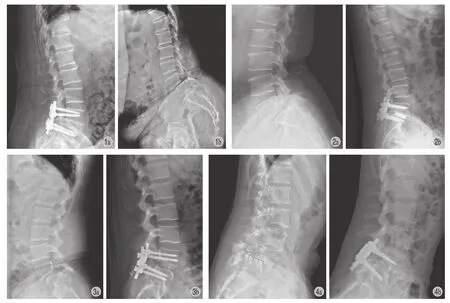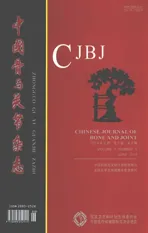退行性腰椎滑脱症与峡部裂性腰椎滑脱症患者的手术疗效比较
2014-02-13黄卫国海涌
黄卫国 海涌
. 论著 Original article .
退行性腰椎滑脱症与峡部裂性腰椎滑脱症患者的手术疗效比较
黄卫国 海涌
目的比较退行性腰椎滑脱症与峡部裂性腰椎滑脱症两组患者手术治疗的临床疗效、安全性、有效性和术后2 年的融合率。方法2005 年1 月至 2011 年 6 月,72 例成人 II、III 度腰椎滑脱症患者接受腰椎后路椎间植骨融合术 (posterior lumbar interbody fusion,PLIF ) 治疗的回顾性临床研究。以腰椎滑脱的病理学改变分为退行性腰椎滑脱症和峡部裂性腰椎滑脱症两组。其中退行性腰椎滑脱症 48 例,Meyerding 分级均为 II 度滑脱;峡部裂性滑脱症 24 例,Meyerding 分级 II 度 10 例、III 度 14 例。所有患者均行减压、复位、椎弓根螺钉固定和植骨融合术。两组患者术前一般资料差异无统计学意义 (P>0.05 )。比较两组患者的手术时间、术中出血量、术后下地活动时间、术后平均住院日和平均年龄,并分别于术前1 天、术后1 个月和术后2 年,采用疼痛视觉模拟评分 (visual analogue scores,VAS ) 和日本骨科学会 (japanese orthopaedic association,JOA ) 腰痛疾患疗效评分进行评价治疗效果。根据术后1 年腰椎 X 线片和 CT 平扫+三维重建评价腰椎融合情况。结果峡部裂性腰椎滑脱症组平均年龄 (48.6±6.9 ) 岁,退行性腰椎滑脱症组 (59.5±9.9 ) 岁,退行性组术中出血量 (343.3±62.4 ) ml、术后下地活动时间 (5.3±2.7 ) 天和术后平均住院日 (8.6±2.4 ) 天分别小于峡部裂性组 (383.8±50.7 ) ml、(7.5±2.5 ) 天、(10.2±3.8 ) 天,两组比较,差异均有统计学意义 (P<0.01 )。峡部裂组手术平均时间略长于退行性组,但差异无统计学意义 (P>0.05 )。术中两组各有1 例硬膜撕裂,结果无差异。JOA 评分:术前1 天,两组差异无统计学意义 (P>0.05 );术后1 个月,退行性组 (24.19±1.21 ) 大于峡部裂性组 (22.83±1.68 ),差异有统计学意义 (P<0.01 );术后2 年,退行性组 (25.33±1.06 ) 大于峡部裂性组(24.04±1.99 ),差异有统计学意义 (P<0.01 )。VAS 评分:术前1 天,两组差异无统计学意义 (P>0.05 );术后1 个月,退行性组 (1.77±0.78 ) 小于峡部裂性组 (3.00±1.02 ),差异有统计学意义 (P<0.01 );术后2 年,退行性组 (1.79±0.87 ) 小于峡部裂性组 (2.96±0.91 ),差异有统计学意义 (P<0.01 )。退行性组有 20 例完全复位,27 例部分复位和1 例未复位;峡部裂组有 9 例完全复位,11 例部分复位和4 例未复位。两组术后1 年的融合率比较,差异无统计学意义 (P>0.05 )。根据 JOA 评分得出临床疗效评价,退行性组:优 36 例,良9 例,可3 例,优良率达 93.75%;峡部裂性组:优 14 例,良 7 例,可3 例,优良率达 87.5%,两组优良率比较,差异有统计学意义 (P<0.05 )。结论峡部裂性组行 PLIF 手术治疗,可以获得与退行性组采用 PLIF 手术治疗相似的安全有效的治疗结果,并且退行性组具有出血少、恢复快、临床疗效更加显著的优点;两组手术时间和术后融合率无明显差异。
椎间盘退行性变;脊椎滑脱;腰椎;脊柱融合术;腰椎峡部裂
腰椎滑脱症 (Spondylolisthesis ) 是指腰椎的椎体间因各种原因造成骨性连接异常而出现上位椎体相对于下位椎体不同程度地移位而出现腰腿痛等临床症候群[1]。对腰椎滑脱的认识始于 1854 年,Kilian描述并命名了这个疾病。腰椎滑脱是慢性腰腿痛的常见原因之一,腰椎滑脱症常见的病理类型有退行性和峡部裂性两种,椎板减压、固定和植骨融合是目前公认的主要治疗方法[2]。采用退行性和峡部裂性腰椎滑脱症手术治疗对比研究的文献报道较少。本研究通过在民航总医院骨科和北京朝阳医院骨科接受手术治疗的成人 II、III 度退行性和峡部裂性腰椎滑脱症患者,对两组接受手术治疗的临床疗效进行分析与比较,评价两组手术治疗的安全性、有效性和融合率,现报告如下。
资料与方法
一、一般资料
纳入标准:(1) II~III 退行性和峡部裂性腰椎滑脱症患者,退行性腰椎滑脱症 48 例,峡部裂性滑脱症 24 例;(2) 首次接受手术治疗的腰椎滑脱症者;(3) 影像学表现与症状、体征一致者。
排除标准:(1) 严重的骨质疏松症者;(2) 发育不良性、创伤性、和病理性腰椎滑脱症者;(3)再次手术或者返修手术者;(4) 伴有腰椎骨折、肿瘤、感染等疾患史者;(5) 影像学表现与症状、体征不一致者。
2005 年1 月至 2011 年 6 月,共有 72 例纳入本研究。其中,退行性腰椎滑脱症组 48 例,男10 例,女 38 例;年龄 46~78 岁,平均 59.5 岁;L4滑脱症 17 例,L5滑脱症 31 例;Meyerding 分级均为 II 度滑脱症患者。峡部裂性滑脱症组 24 例,男8 例,女 16 例;年龄 39~70 岁,平均 48.6 岁;L4滑脱症 9 例,L5滑脱症 15 例;Meyerding 分级 II 度腰椎滑脱症 10 例,III 度腰椎滑脱症 14 例。所选病例均经过非手术治疗无效后入院。在两组病例的病程和年龄上分析,退行性腰椎滑脱症患者平均年龄较峡部裂性腰椎滑脱症患者年龄大 11 岁,病程长于峡部裂性腰椎滑脱症约 10 年。
二、手术方法
患者采用全麻或者连续硬膜外麻醉,俯卧位,腹部悬空,C 型臂透视定位后,取后正中入路,显露滑移腰椎及下位椎体的横突和关节突。按 Weistain法在滑移腰椎两侧各置入1 枚提拉复位钉,在相邻下位椎体两侧各置入1 枚椎弓根螺钉;全椎板减压、扩大侧隐窝和神经管,均切除双侧小关节突及咬除其周围增生组织,椎板减压后彻底显露硬膜囊、显露椎间隙,切除椎间盘组织,松解出口神经根和行走神经根,处理上下软骨终板;部分滑脱症病例通过提拉复位钉获得完全或者部分复位,部分滑脱症病例还需要用小号的 Cobb’s 骨膜剥离器插入椎间隙翘起移位的椎体帮助复位。通过椎间隙植入自体碎骨,安装 SRS 纵向连杆,在适度撑开椎间隙的基础上,然后斜向置入单枚或者两枚椎间植骨融合器并夯实,螺钉间适度加压固定。术前如果X 线片腰椎正侧位测量发现患者的椎体较正常椎体大时,选用两枚椎间融合器;在置入椎间植骨融合器时,发现置入两枚椎间融合器的时间较单枚平均延长 20 min,复位、植骨量相对于单枚椎间融合器无明显差异。
三、术后处理
术后 36~48 h 拔除伤口引流管,根据伤口有无红肿、渗出多少、有无体温异常及持续时间及 CRP等监测,术后适当使用抗生素;常规使用甘露醇、地塞米松3 天。拔管后开始行双下肢直腿抬高锻炼,嘱患者3 周后进行腰背肌功能锻炼,3~4 周在腰围保护下地活动。
四、观察指标
记录两组患者平均年龄、手术时间、术中出血量、术后下地活动时间和术后平均住院日。并于术前1 天、术后1 个月和术后2 年采用疼痛视觉模拟评分 (visual analogue scores,VAS ) 和日本骨科学会(japanese orthopaedic association,JOA ) 腰痛疾患疗效评分进行评价治疗效果[3]。根据术后1 年腰椎X 线片和 CT 平扫+三维重建评价腰椎融合情况。随访时均拍摄站立位的 X 线腰椎正侧位及过伸过屈位片,分别通过腰椎侧位动力片的测量,来确定腰椎融合的具体情况。如果 X 线片不能确定融合情况,则须行腰椎 CT 三维重建薄层扫描。植骨融合的标准如下[4]:(1) 明确的骨小梁穿过椎间隙;(2) 侧位过伸、过屈位 X 线片上融合节段间的角度变化<4°;(3) 融合器与椎体间的界面无明显的透光影。只有符合以上3 个标准者,才确认为达到坚强融合[5]。为减少误差,测量工作由同一技术人员负责。滑脱复位率,即 (术前滑脱率-术后滑脱率 ) / 术前滑脱率×100% 作为评价滑脱复位程度。
五、疗效评价
采用 JOA 评分改善率 (RR )=(术后评分-术前评分 ) / (29-术前评分 ) ×100%。结果判定:<25% 或者 JOA 评分低于术前为差,~50% 为可,~75% 为良,>75% 为优。
六、统计学处理
结果采用 SPSS19.0 软件进行统计学分析。同一指标两组间比较采用 t 检验,同一指标组内组内不同时间点结果的比较采用方差分析,P<0.05 为差异有统计学意义。
结 果
本组 72 例均顺利完成手术。术后3 例出现切口边缘发黑、渗出、结痂,经换药后愈合,其余69 例切口均一期愈合拆线。3 例出现鞍区麻木、排尿无力等马尾神经症状,经治疗,术后 1~3 个月恢复;2 例术中发生硬膜撕裂,均在术中进行修补,术后未发生脑脊液漏。
峡部裂性组平均年龄较退行性组年轻近 11 岁;退行性组术中出血量、术后下地活动时间和术后平均住院日明显优于峡部裂性组,两组以上各指标比较差异均有统计学意义 (P<0.01 )。峡部裂组平均手术时间略长于退行性组,两组比较差异无统计学意义 (P>0.05 ) (表1)。两组分别于术前1 天、术后1 个月及术后2 年随访时的 VAS 和 JOA 功能评分进行评价与比较。JOA 评分,术前1 天两组差异无统计学意义 (P>0.05 ),术后1 个月及术后2 年两组分别比较,差异均有统计学意义 (P<0.01 ) (表2);VAS 评分,术前1 天两组差异无统计学意义 (P>0.05 ),术后1 个月及术后2 年两组分别比较,差异均有统计学意义 (P<0.01 ) (表3),(图 1~4 )。

图1 患者,女,56 岁 a:术前 X 线侧位示 L4椎体 II 度滑脱;b:术后 X 线侧位示腰椎滑脱部分复位图2 患者,女,62 岁 a:术前 X 线侧位示 L5椎体 II 度滑脱;b:术后 X 线侧位示腰椎滑脱完全复位图3 患者,女,53 岁 a:术前 X 线侧位示 L5椎体 III 度滑脱;b:术后 X 线侧位示腰椎滑脱完全复位图4 患者,女,55 岁 a:术前 X 线侧位示 L5椎体 III 度滑脱;b:术后 X 线侧位示腰椎滑脱部分复位Fig.1 Yongxin Cao, female, 56 years a: L4of the Grade II spondylolisthesis of the lateral radiograph of the preoperative and postoperative; b: Shown that partial reduction of the lateral radiograph postoperative of the spondylolisthesisFig.2 YanRong Shi, female, 62 years a: L5of the grade II spondylolisthesis of the lateral radiograph of the preoperative and postoperative; b: Shown that of the lateral radiograph postoperative of the spondylolisthesisFig.3 Female ,53 years a: L5of the Grade III spondylolisthesis of the lateral radiograph of the preoperative and postoperative; b: Shown that reduction of the lateral radiograph postoperative of the spondylolisthesisFig.4 Female, 55 years a: L5of the Grade III spondylolisthesis of the lateral radiograph of the preoperative and postoperative; b: Shown that partial reduction of the lateral radiograph postoperative of the spondylolisthesis
退行性组完全复位 20 例,部分复位 27 例,未复位1 例。峡部裂组完全复位 9 例,其中 II 度2 例,III 度 7 例;部分复位 11 例,其中 II 度 6 例,III 度5 例;未复位4 例,其中 II 度2 例,III 度2 例。
术后1 年,退行性组完全融合 47 例,融合率98%;峡部裂性组完全融合 23 例,融合率 97%,两组比较差异无统计学意义 (P>0.05 )。
表1 两组患者围手术期情况 (±s)Tab.1 Two groups of patients perioperative situation (±s)

表1 两组患者围手术期情况 (±s)Tab.1 Two groups of patients perioperative situation (±s)
组别 术后下地时间 (天 ) 术后平均住院日 (天 ) 平均年龄 (岁 ) 术中出血量 (ml ) 手术时间 (min )退行性腰椎滑脱症 5.3±2.7 8.6±2.4 59.5±9.9 343.3±62.4 126.3±16.0峡部裂性腰椎滑脱症 7.5±2.5 10.2±3.8 48.6±6.9 383.8±50.7 128.3±14.3 P 值 <0.01 <0.01 <0.01 <0.01 >0.05
表2 两组患者不同时间点腰痛、腿痛 JOA 评分 (±s)Tab.2 Two group of patients different time points suffering back pain, leg pain JOA score (±s)

表2 两组患者不同时间点腰痛、腿痛 JOA 评分 (±s)Tab.2 Two group of patients different time points suffering back pain, leg pain JOA score (±s)
组别 术前1 天 术后1 个月 术后2 年退行性腰椎滑脱症 15.42±1.32 24.19±1.21 25.33±1.06峡部裂性腰椎滑脱症 14.88±1.42 22.83±1.68 24.04±1.99 P 值 >0.05 <0.01 <0.01
表3 两组患者不同时间点腰痛、腿痛 VAS 评分 (±s)Tab.3 Two group of patients different time points suffering back pain, leg pain JOA score (±s)

表3 两组患者不同时间点腰痛、腿痛 VAS 评分 (±s)Tab.3 Two group of patients different time points suffering back pain, leg pain JOA score (±s)
组别 术前1 天 术后1 个月 术后2 年退行性腰椎滑脱症 7.48±1.27 1.77±0.78 1.79±0.87峡部裂性腰椎滑脱症 7.00±1.22 3.00±1.02 2.96±0.91 P 值 >0.05 <0.01 <0.01
根据 JOA 评分得出临床疗效评价,退行性组:优 36 例,良 9 例,可3 例,优良率达 93.75%;峡部裂性组:优 14 例,良 7 例,可3 例,优良率达87.5%,两组优良率差异有统计学意义 (P<0.05 )。
讨 论
腰椎滑脱是腰腿痛的常见原因之一。对于非手术治疗无效或者效果欠佳者,多数学者主张采取手术治疗,以恢复腰椎稳定性和腰骶部的生理前凸角,解除椎管及神经根管的狭窄,消除或者明显改善症状,结合植骨融合内固定,重建腰椎的正常生理曲度。
从本组病例的不同病理特点来分析,峡部裂性腰椎滑脱症的主要病理改变是:峡部裂缺损区域瘢痕形成,椎体与上关节突向前滑脱,导致椎弓根分离或者异常活动;退行性腰椎滑脱症的病理改变主要是椎间盘退变、狭窄以及突出,关节突增生肥大,椎间孔变小及侧隐窝狭窄,出现神经根卡压症状;椎弓椎板完整而前后纵韧带松弛,导致脊柱的稳定性明显下降所致。从两组术前资料分析发现,峡部裂性腰椎滑脱症组诊治年龄较退行性腰椎滑脱症组平均年轻近 11 岁,且差异有统计学意义 (P<0.01 );女性发病比例明显高于男性,由于总体病例样本量较少而未做统计学分析。
如何解除或者明显改善患者术后的临床症状,是我们共同关注的问题。虽然退行性和峡部裂性腰椎滑脱症病理改变有所不同,手术方式有腰椎后路椎间植骨融合术 (posterior lumbar interbody fusion,PLIF ) 和腰椎经椎间孔植骨融合术 (TLIF ) 等,但是PLIF 能显著增加脊柱后方的稳定性,结合椎间植骨融合恢复脊柱的前中柱,符合 Denis 三柱理论,使脊柱获得前、中、后三柱稳定性。行 PLIF 手术时应彻底地行椎板减压,同时切除增生肥大的关节突,行神经管和神经根管的充分减压和腰椎滑脱椎体周围的充分松解,为椎体间撑开复位及植骨打下了良好的基础,也是术后恢复腰椎失状位平衡的关键所在,为患者术后解除或者明显改善症状提供条件。术中椎间充分足量的植骨加单枚或者两枚植骨融合器 (Cage ) 的使用,起到对腰椎前中柱的支撑作用,才能够有效地防止 Cage 的下沉、移位和松动,可以较好地恢复椎间高度。加上后柱椎弓根螺钉的张力带作用,同时恢复了脊柱的三柱稳定结构, 应力重新分布至后柱,椎管容积相对增大,起到了对神经根明显的减压作用,因此腰骶角得以恢复,使滑脱的腰椎得到完全或者部分复位。行椎间置入 Cage 的过程中,有神经根损伤等风险,以及 Cage 置入位置不佳等不足,因此要求我们在手术操作时要格外地仔细,而对于 Cage 的位置,术中可通过使用 C 型臂透视及时调整。患者术后还须行胸腰围支具保护3 个月,因此内固定器械的应用是滑脱椎体复位并维持稳定的必要手段,植骨融合是保持腰椎长期稳定的关键[6]。本组峡部裂组 24 例接受 PLIF;退行性腰椎滑脱症 48 例也接受 PLIF。在两组术后的随访中,下肢神经根症状、腰骶部疼痛和部分患者鞍区麻木等症状均较术前症状明显改善。
从退行性组与峡部裂组术中对增生肥大的关节突处理和椎板减压椎弓根管松解与峡部裂组比较来分析,由于峡部裂性滑脱峡部骨质缺损,术中须对其进行复位植骨融合修复等处理,使得峡部裂组术中出血量明显较退行性腰椎滑脱症组多 50~120 ml,且有统计学意义 (P<0.01 );同时发现峡部裂组较退行性组平均手术时间长 10~30 min,但两组差异无统计学意义 (P>0.05 )。
关于滑脱椎体是否需要复位及复位程度如何,目前仍存有争议。Poussa 等[7]认为,对腰椎滑脱进行原位融合效果令人满意,相反复位会带来许多并发症。但多数学者都主张应用脊柱矫形内固定系统或其他方法尽量复位滑脱椎体,滑脱椎体的解剖复位能恢复腰骶椎序列,增大复位后的椎体间接触面积,有利于椎体间的植骨融合,从而明显改善术后临床症状[2,8-9]。张忠民等[10]认为,复位还可以改善腰骶段后凸畸形,改善姿势和外形,有利于恢复脊柱的正常生物力学,从而明显改善术后症状。而滑脱的手术治疗不仅在于扩大椎管的失状径容积,同时还可以恢复椎间高度及稳定椎节。刘玉增等[11]认为,有限复位不仅明显恢复腰椎生理曲度和生物学力线,尤其在 L4~L5椎间隙;结合有效椎间融合,有助于减少不融合发生率;后方适度加压,可以减小神经根张力,从而改善和解除症状。张伟等[12]认为,矫正腰骶段后凸畸形、恢复滑脱椎间隙的高度、重建符合生理要求的生物力学内环境更重要,而复位组与未复位组术后无显著性差异。由于两组间 II、III 分布不均,故未做复位程度间的比较。本组 72 例中5 例未获得复位,分析其原因是多方面的,有患者病程长,峡部裂处增生明显和周围组织结构松解不彻底等原因。
然而,有研究表明,腰椎退行性滑脱症和峡部裂性滑脱症患者具有相同的骨盆形态,由于两组病因学不同及代偿机制存在差异,两者表现出不同的脊柱失状面形态,腰椎峡部裂性滑脱症表现出更大的胸椎后凸角 (thoracic kyphosis,TK )、腰椎前凸角(lumber lordosis,LL ) 和滑脱角,退行性腰椎滑脱症更易出现躯干前倾,即失状面轴向垂直距离 (sagittal vertical axis,SVA )[13]。这表明,腰椎滑脱症术后失状位平衡也是影响患者临床疗效的一个重要因素。因此,我们提倡尽可能地进行滑脱椎体的复位,以恢复腰椎的生理前凸角,这有利于提高腰椎的稳定性和改善临床疗效。
综上所述,退行性和峡部裂性腰椎滑脱症术后临床疗效影响因素较多。与患者的年龄、腰椎滑脱的病变程度、滑脱的时间、退行性和峡部裂性各自的病理特点、手术中椎管和神经根管的彻底减压和松解、复位以及植骨融合固定等因素相关。
本组中峡部裂组较退行性组年轻近 11 岁,术中出血量较多,术后下地活动时间晚、术后平均住院日长,两组差异有统计学意义;但两组术后1 个月及术后2 年随访 JOA 和 VAS 评分较术前均有明显改善,且退行性组较峡部裂性组术后临床疗效改善更加显著。因此我们认为:峡部裂性组行 PLIF 手术治疗,可以获得与退行性组采用 PLIF 手术治疗相似的安全有效的治疗结果,并且退行性组具有出血少、恢复快、临床疗效更加显著的优点;两组手术时间和术后融合率差异无统计学意义。本组研究为回顾性研究,所收集的病例资料为 72 例,样本量相对不足,希望在未来的研究中增加样本总量,尽可能减少误差。
[1]海涌, 周跃, 郑召民, 等. 脊柱外科治疗原则. 北京: 人民军医出版社, 2011: 326-351.
[2]Ruf M, Koch H, Melcher RP, et al. Anatomic reduction and monosegmental fusion in high-grade developmental spondylolisthesis. Spine, 2006, 31(3):269-274.
[3]蒋协远, 王大伟, 韩士章, 等. 骨科临床疗效评价标准. 北京:人民卫生出版社, 2005: 107-108;123-124.
[4]Suk KS, Lee HM, Kim NH, et al. Unilateral versus bilateral pedicle screw fixation in lumbar spinal fusion. Spine, 2000, 25(14):1843-1847.
[5]陈志明, 马华松, 赵杰, 等. 椎弓根螺钉提拉复位与椎间隙撑开复位治疗峡部裂型腰椎滑脱症的临床效果观察. 中国脊柱脊髓杂志, 2010, 20(2):89-93.
[6]侯树勋, 邱贵兴, 陈仲强, 等. 脊柱外科学. 北京: 人民军医出版社, 2005: 829-846.
[7]Poussa M, Remes V, Lamberg T, et al. Treatment of severe spondylolisthesis in adolescence with reduction or fusion in situ: long-term clinical, radiologic, and functional outcome. Spine, 2006, 31(5):583-590.
[8]Floman Y, Millgram MA, Ashkenazi E, et al. Instrumented slip reduction and fusion for painful unstable isthmic spondylolisthesis in adults. J Spinal Disord Tech, 2008, 21(7): 477-483.
[9]Goyal N, Wimberley DW, Hyatt A, et al. Radiographic and clinical outcomes after instrumented reduction and transforaminal lumbar interbody fusion of mid and highgrade isthmic spondylolisthesis. J Spinal Disord Tech, 2009, 22(5):321-327.
[10]张忠民, 陈建庭, 金大地. 两种椎间融合材料在治疗重度腰椎滑脱中的疗效比较. 中国骨与关节外科, 2008, 1(1):16-20.
[11]刘玉增, 海涌, 杨晋才, 等. 有限复位内固定椎间融合术治疗稳定的退变性腰椎滑脱症临床疗效的回顾性分析. 中华老年多器官疾病杂志, 2012, 11(10):746-749.
[12]张伟, 杨启友. 腰椎滑脱症手术复位与未复位的对比. 中国矫形外科杂志, 2007, 15(3):180-182.
[13]刘勇, 刘臻, 朱锋, 等. 成人腰椎峡部裂性滑脱症与退变性滑脱症患者脊柱骨盆矢状面形态学研究. 中国脊柱脊髓杂志, 2013, 23(4):307-311.
(本文编辑:马超 代琴 )
Comparison of the surgical results in the patients with degenerative spondylolisthesis and isthmic spondylolisthesis
HUANG Wei-guo, HAI Yong. Department of Orthopedics, Civil Aviation General Hospital, Clinical Medical College of Civil Aviation, Peking University, Beijing, 100123, PRC
ObjectiveTo compare the clinical results in the surgical treatment of degenerative spondylolisthesis and isthmic spondylolisthesis, regarding the safety, curative effects and fusion rate at2 years after the operation.MethodsA retrospective study was performed on 72 adult patients with grade II-III spondylolisthesis who underwent posterior lumbar interbody fusion (PLIF ) from January 2005 to June 2011. All the patients were divided into2 groups based on the pathological changes of lumbar spondylolisthesis, including the degenerative spondylolisthesis group (n=48 ) and the isthmic spondylolisthesis group (n=24 ). According to the Meyerding grading system for spondylolisthesis, there were 48 cases of grade II in the degenerative spondylolisthesis group and 10 cases of grade II and 14 cases of grade III in the isthmic spondylolisthesis group. All the patients underwentdecompression, reduction, pedicle screw fxation and spinal fusion. The differences in the preoperative general data between the2 groups were not statistically significant (P>0.05 ). The operation time, intraoperative blood loss, postoperative ambulation time, postoperative average length of stay and average age were compared between the2 groups. The curative outcomes were evaluated based on the Visual Analogue Scale (VAS ) and Japanese Orthopedic Association (JOA ) assessment criteria for back pain at1 day before the surgery and1 month and2 years after the surgery. The lumbar fusion was observed by the X-ray and 3-dimensional reconstruction of CT scan at1 year after the surgery.ResultsThe average age of the isthmic spondylolisthesis group was (48.6±6.9 ) years old, who was younger than (59.5±9.9 ) years old of the degenerative spondylolisthesis group. The intraoperative blood loss, postoperative ambulation time and postoperative average length of stay were (343.3±62.4 ) ml, 5.3±2.7d and (8.6±2.4 ) d in the degenerative spondylolisthesis group, which were all less than (383.8±50.7 ) ml, (7.5±2.5 ) d and (10.2±3.8 ) d in the isthmic spondylolisthesis group. The differences between them were statistically signifcant (P<0.01 ). The average operation time in the isthmic spondylolisthesis group was slightly longer than that in the degenerative spondylolisthesis group, with no statistically signifcant differences between them (P>0.05 ). In each group there was1 patient with dural laceration, and the results were not statistically different. The differences in the JOA score were not statistically signifcant between the2 groups at1 day before the surgery (P>0.05 ). The JOA score was (24.19±1.21 ) points in the degenerative spondylolisthesis group at1 month after the operation, which was larger than (22.83±1.68 ) points in the isthmic spondylolisthesis group, and the differences between them were statistically different (P<0.01 ). The JOA score was (25.33±1.06 ) points in the degenerative spondylolisthesis group at2 years after the operation, which was larger than (24.04±1.99 ) points in the isthmic spondylolisthesis group, and the differences between them were statistically different (P<0.01 ). The differences in the VAS score were not statistically significant between the2 groups at1 day before the surgery (P>0.05 ). The VAS score was (1.77±0.78 ) points in the degenerative spondylolisthesis group at1 month after the operation, which was larger than (3.00±1.02 ) points in the isthmic spondylolisthesis group, and the differences between them were statistically different (P<0.01 ). The VAS score was (1.79±0.87 ) points in the degenerative spondylolisthesis group at2 years after the operation, which was larger than (2.96±0.91 ) points in the isthmic spondylolisthesis group, and the differences between them were statistically different (P<0.01 ). Complete reduction was achieved in 20 cases, partial reduction in 27 cases and no reduction in1 case in the degenerative spondylolisthesis group. While in the degenerative spondylolisthesis group, complete reduction was obtained in 9 cases, partial reduction in 11 cases and no reduction in4 cases. The differences in the fusion rate at1 year after the surgery were not statistically signifcant between the2 groups (P>0.05 ). Based on the JOA score, there were 36 excellent cases, 9 good cases and3 fair cases in the degenerative spondylolisthesis group and the excellent and good rate was 93.75%. While in the isthmic spondylolisthesis group, there were 14 excellent cases, 7 good cases and3 fair cases and the excellent and good rate was 87.5%. The differences in the excellent and good rate between the2 groups were statistically significant (P<0.05 ).ConclusionsThe safe and effective curative outcomes can be obtained in the isthmic spondylolisthesis group with the treatment of PLIF, which are just similar to that in the degenerative spondylolisthesis group with the treatment of PLIF. However, there will be less bleeding, faster recovery and more satisfactory clinical results in the degenerative spondylolisthesis group. No obvious differences exist in the operation time and postoperative fusion rate between the2 groups.
Intervertebral disc degeneration; Spondylolysis; Lumbar vertebrae; Spinal fusion; Lumber spondyloschisis
10.3969/j.issn.2095-252X.2014.06.013
R681.5
100123 北京大学民航临床医学院民航总医院骨科;100020 首都医科大学附属北京朝阳医院骨科
2014-01-10 )
